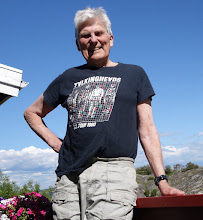Three or four summers ago –long ago to put it simply-I sat up on Mount Philo in Charlotte, Vermont and looked out over this scene. Lake Champlain and beyond that out of sight the Adirondack Mountains of New York State and directly below me many large and expensive homes on broad expanses of grass
A beautiful view, every day, but I had other thoughts arising from the fact that I live in Sweden where the word “bergvaerme” (geothermal energy from bedrock) is a household word. Why so? Because in a country of 9 million people there are to date 370,000 geothermal energy systems in use. "Only in Sweden", I thought.
My next thought was: “I’ll bet that all of these expensive homes are heated by oil or natural gas.” Why so, if the USA is in such great need of freeing itself from fossil fuel dependence.?
I wrote a letter to the Burlington Free Press (BFP) and sent Emails to five University of Vermont Professors. My suggestion that geothermal might be an alternative was ridiculed in the BFP. No professor answered my Email. Geothermal? “Never in Vermont” apparently
In my city in Sweden, Linkoeping, the oil burner is practically extinct. My home, like most, is heated by hot water piped from a high-tech municipal waste incinerator. My neighbor’s home, like many others is heated by closed-loop geothermal.
Now these many years later there are small signs of hope blowing in the wind – no wind turbines below Mount Philo, you may have noted. The most visible sign of hope came from an initiative taken by the Senator from Vermont, the honorable Bernie Sanders who held a forum in 2010 where geothermal was mentioned for the first time. But talk is not action.
The first I discovered – thanks to my UVM daughter number one – was the well hidden existence of a geothermal system at the Vermont Vietnam Memorial on Route I-89 just after you enter Vermont from New Hampshire. Here it is. Have you been there?
If you have I will bet you never knew that the beautiful building is cooled and heated by geothermal energy. No oil, no wind turbine, no chimney, no smoke - a geothermal system is invisible. You won’t learn much about geothermal there, but maybe that can change. “Never in Sweden” a welcoming rest place with free coffee, I might add.
But now, July 2010, Eureka. I visited Champlain College in Burlington and found a professor to whom I posed this question: “Do you know where the geothermal project is. He (Name to be added if I can find his card) said, yes, follow me, after a short walk he pointed to this building, Perry Hall, soon to be the new Admissions Office complete with brand new geothermal system. Nice place. Cool in the both the geothermal sense and the vernacular.
Today I close by showing you the two essential elements of a geothermal system used here (open-loop system is the term). More another day.
 In looking at these two small elements you will realize, I hope, why geothermal goes unnoticed and unremarked. On the left, the source well, with the bottom deep in the bedrock below the site. Cool water is pumped up from this well and into the heat exchanger and heat pump system in the basement of Perry Hall.
In looking at these two small elements you will realize, I hope, why geothermal goes unnoticed and unremarked. On the left, the source well, with the bottom deep in the bedrock below the site. Cool water is pumped up from this well and into the heat exchanger and heat pump system in the basement of Perry Hall.On the right, the return well through which the slightly warmer water is returned to the bedrock.
Water in, water out. More another day. It works. In Perry Hall, at least, the oil burner is extinct. And in signing off, thanks to Michel George of Champlain College who in good time will tell you the whole story at the Champlain College web site. And if any UVM Professor reads this, Why not "Even at UVM"?
Footnote added 24 July 2010 The Champlain College web site has a complete photo album on Perry Hall but no photos of the geothermal system. Therefore the two above can serve as a complement and soon additional photos in a new post on the system inside. The URL is:
Footnote added 24 July 2010 The Champlain College web site has a complete photo album on Perry Hall but no photos of the geothermal system. Therefore the two above can serve as a complement and soon additional photos in a new post on the system inside. The URL is:
http://www.champlain.edu/News-and-Events/News/Perry-Hall-June-2010.html


























